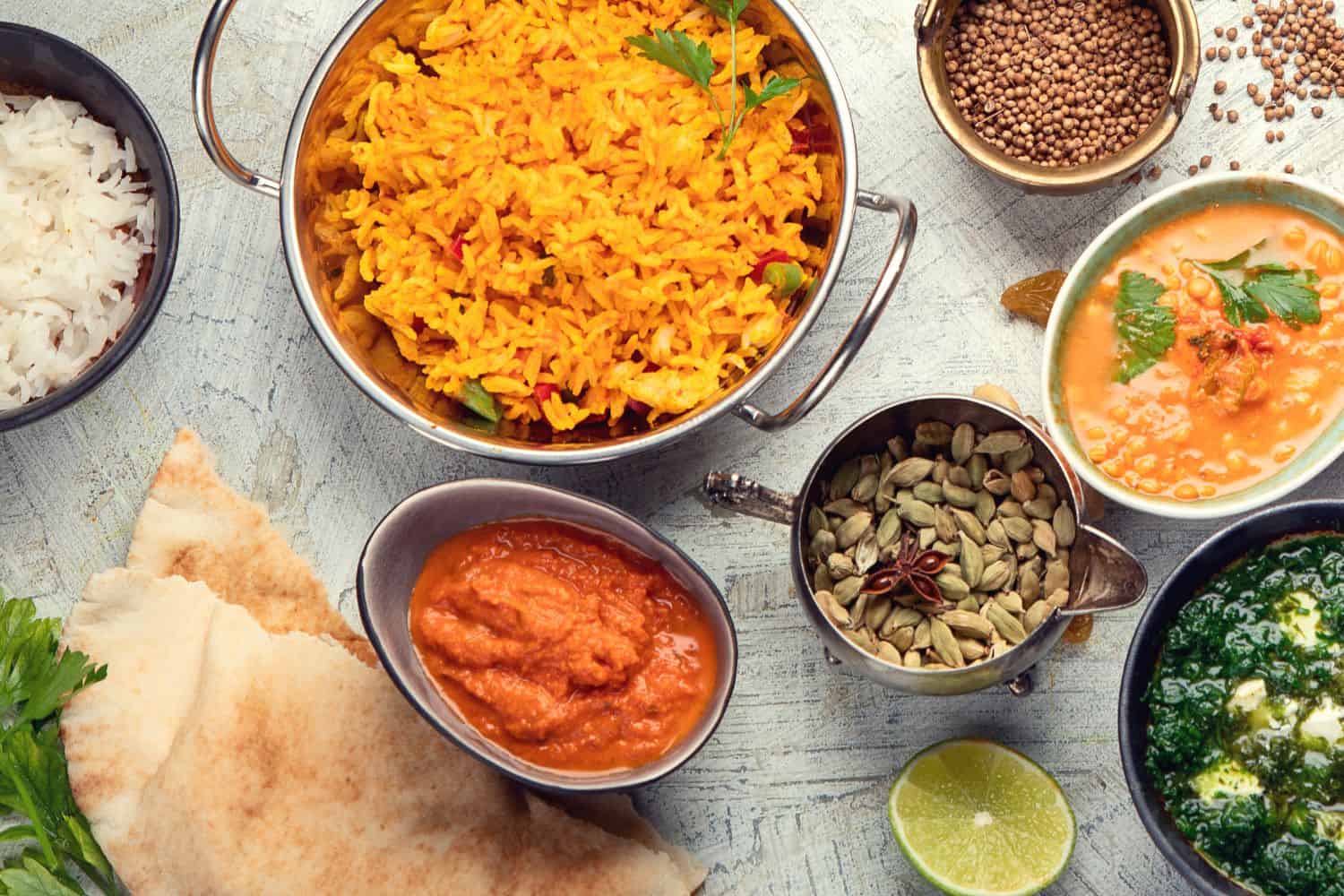Table of Contents
Embarking on a culinary journey through Sudan reveals a captivating tapestry of flavors and cultural heritage. The food from Sudan, influenced by African, Arabian, and Mediterranean traditions, offers a delightful fusion of tastes. From beloved traditional dishes to tantalizing street cuisine, Sudanese food is a treasure trove of mouthwatering delights that showcase the richness of its food culture. Let’s dive into this diverse and vibrant world of the food culture of Sudan.
Top Ingredients of Sudanese Cuisine
In Sudanese cuisine, a rich tapestry of flavors is woven through the skillful combination of various ingredients. Here is a list of the most commonly used ingredients that form the foundation of Sudanese culinary traditions:
Sorghum: A staple in Sudanese cuisine, sorghum is often used to make traditional dishes like Asida (a thick porridge) and Kisra (fermented flatbread).
Lamb and Beef: Lamb and beef are the most popular meats in Sudan and are essential ingredients in many traditional dishes like Ful Medames, Shaiyah (a meat stew), and Mulukhiyah.
Spices: Sudanese cuisine relies on an array of aromatic spices, including cinnamon, cloves, cumin, ginger, and fenugreek, to enhance the flavor of their dishes.
Yogurt: Yogurt is a fundamental component of Sudanese cuisine, commonly used as a side dish, marinade, or base for sauces.
Onions and Garlic: These two ingredients form the core of many Sudanese recipes, providing a savory foundation for various dishes.
Fava Beans: Fava beans are a versatile ingredient used in dishes like Ful Medames, a popular Sudanese breakfast dish.
Okra: Okra is a key ingredient in Sudanese cuisine, particularly in dishes like Bamia (okra stew) and Mulukhiyah (a green leafy stew).
Tomatoes: Tomatoes are widely used in Sudanese cooking, adding a tangy and flavorful element to soups, stews, and sauces.
Fresh Herbs: Sudanese cuisine often incorporates fresh herbs like cilantro, parsley, and dill to add a burst of freshness and aroma to various dishes.
Dates and Nuts: Dates and a variety of nuts, such as peanuts and almonds, are frequently used in Sudanese desserts and snacks, offering sweetness and texture.
Sudanese cuisine also includes a wide range of indigenous vegetables, fruits, and regional produce, all contributing to the diverse and enticing flavors found in Sudanese food culture.
The variety of food from Sudanese cuisine
Sudanese cuisine offers a captivating array of flavors and dishes that reflect the nation’s rich history and cultural diversity. Influenced by African, Arab, and Middle Eastern culinary traditions, Sudanese food presents a unique blend of ingredients and cooking techniques. One of the most renowned dishes is Kisra, a traditional Sudanese flatbread made from sorghum or millet, often served with a savory stew called Marak. This dish symbolizes Sudanese hospitality and is commonly enjoyed in various gatherings. Another beloved Sudanese specialty is Kofta, seasoned ground meat skewers grilled to perfection and served with a flavorful dipping sauce.
The heartiness of Sudanese cuisine is exemplified in its hearty stews, such as Bamia, a flavorful okra stew cooked with tender chunks of meat and aromatic spices, typically served with a side of rice. For a vegetarian option, Ful Medames stands out, featuring mashed fava beans seasoned with garlic, onions, and spices, served with bread or flatbreads. Another popular choice is Aseeda, a sweet porridge-like dish made from wheat or sorghum flour, often garnished with honey or sesame seeds.
Indulging the sweet tooth, Sudanese cuisine presents delightful desserts like Basbousa, a sweet semolina cake soaked in sugar syrup and garnished with almonds or coconut flakes, enjoyed on special occasions. The diversity of Sudanese food is further highlighted in its regional specialties, with each area showcasing distinct recipes and culinary traditions. Whether savoring the flavors of Kofta or delighting in the comforting taste of Bamia, exploring the variety of Sudanese cuisine is an adventure in cultural richness and gastronomic pleasure.
While visiting beautiful Sudan, you can experience the best of Sudanese recipes. We offer a wide range of tours in Sudan that you can choose to explore the country’s culinary delights.
Best Foods in Sudan
Sudanese cuisine offers a diverse and flavorful range of dishes that excite the palate with their unique flavors and cultural significance. While it’s challenging to compile an exhaustive list of the “best” foods, there are certain dishes that hold a special place in Sudanese culinary tradition.
Sudanese cooking is renowned for its skillful use of spices, including ingredients like fenugreek, coriander, cardamom, turmeric, cloves, cinnamon, ginger, garlic, chilies, saffron, black pepper, and dried mint. These aromatic spices, when combined with fresh herbs, create a delightful medley of flavors that make Sudanese cuisine truly remarkable.
Most famous Sudanese foods
Here are the top most famous foods in Sudan that have garnered recognition both locally and internationally:
Kebda Shakshouka: A beloved Sudanese dish, Kebda Shakshouka is a flavorful combination of sautéed liver (usually lamb or beef liver) with tomatoes, onions, garlic, and a blend of spices like cumin and paprika. It’s often served with crusty bread or Sudanese flatbread, making it a popular street food and breakfast option.
Kisra: Kisra is a traditional Sudanese flatbread made from fermented sorghum or millet dough. It’s thin, slightly tangy, and often used as a staple food to accompany various stews, such as lentil or okra stews. Kisra is a fundamental part of Sudanese cuisine and is enjoyed in many households.
Mulukhiyah: This leafy green stew is a Sudanese favorite. Mulukhiyah leaves are simmered with a meat of choice (often chicken or lamb) and flavored with garlic, coriander, and other spices. The dish is served over a bed of white rice and is known for its unique taste and nutritional value.
Ful Medames: Ful Medames is a popular breakfast dish in Sudan. It consists of mashed fava beans mixed with ingredients like olive oil, garlic, lemon juice, and various spices. It’s traditionally served with Sudanese flatbread or bread rolls and is a nutritious and satisfying morning meal.
Bajia: Sudanese Bajia are deep-fried snacks made from ground fava beans or chickpeas mixed with herbs and spices. They are crispy on the outside and soft on the inside, making them a delightful street food option enjoyed throughout Sudan.
Gurasa: Gurasa is a type of Sudanese bread that is similar to pita bread but thicker. It’s a versatile bread used to scoop up stews, dips, and salads. Gurasa is a common accompaniment to many Sudanese meals.
These renowned Sudanese dishes showcase the flavors and culinary traditions of Sudan, appealing to both local tastes and international food enthusiasts.
Sudanese Desserts
Sudanese desserts offer a delightful conclusion to a satisfying meal, showcasing a blend of sweet flavors and delicate textures. These desserts are deeply rooted in Sudanese culture and are often enjoyed during celebrations, festivals, and special occasions. Some popular Sudanese desserts include:
Basbousa: Basbousa is a sweet semolina cake soaked in a sugar syrup infused with rosewater or orange blossom water. It is often garnished with almonds or desiccated coconut, giving it a delightful nutty texture.
Ful Sudani: Ful Sudani is a Sudanese dessert made from fava beans, sugar, and aromatic spices like cardamom and cinnamon. It is cooked until the beans become tender and sweet, creating a unique and flavorful dessert.
Gurasa: Gurasa is a Sudanese flatbread that can also be enjoyed as a dessert. It is made from flour, sugar, and yeast, giving it a slightly sweet taste. Gurasa is often served with honey or a drizzle of sugar syrup.
Tamarind Juice: While not a traditional dessert, tamarind juice is a popular and refreshing sweet beverage in Sudan. Tamarind pulp is mixed with water and sweetened with sugar to create a tangy and sweet drink that is perfect for quenching your thirst on a hot day.
These Sudanese desserts offer a delightful exploration of flavors and textures, reflecting the rich culinary traditions of Sudan. They are often enjoyed as a sweet conclusion to a meal or during special gatherings and celebrations.
The culture behind Sudanese food
The culture behind Sudanese food is deeply rooted in tradition, hospitality, and community. Sudanese cuisine reflects the country’s rich history and diverse cultural influences, blending elements from African, Arab, and Middle Eastern culinary traditions. Food holds significant cultural importance in Sudan and plays a central role in social gatherings, family events, and religious celebrations.
Hospitality is a cornerstone of Sudanese culture, and sharing food with guests is a deeply ingrained tradition. When visitors arrive at a Sudanese home, they are warmly welcomed with an array of delicious dishes, reflecting the host’s generosity and desire to make their guests feel at home. Meals are often communal affairs, with everyone seated around a shared platter, emphasizing the importance of togetherness and solidarity in Sudanese culture.
Also, read:
Khartoum, Omdurman, and Port Sudan
Take a culinary journey through Khartoum, Omdurman, and Port Sudan, and immerse yourself in the captivating flavors that have been crafted and cherished for generations in Sudan. Let the traditional foods of each city paint a flavorful picture of Sudanese culinary heritage, inviting you to savor the unique delights of these remarkable regions.
Within the enchanting world of Sudanese cuisine, each region brings its own distinct flavors and culinary traditions. Let’s embark on a journey to Khartoum, Omdurman, and Port Sudan, and discover the delightful differences in their traditional foods.
The variations in dishes from each Sudanese city can be attributed to a combination of factors, including geography, historical influences, and the majority ethnic group residing in each region. Sudan’s diverse landscape and geographical features, such as the Nile River, deserts, and coastal areas, have influenced the availability of certain ingredients and agricultural practices in different regions. This, in turn, has contributed to variations in the types of dishes that have evolved in each city.
Khartoum’s Khartoumi Kebab features succulent grilled meats, often marinated in a flavorful blend of spices and served with flatbreads, representing the warm hospitality of the region. Omdurman’s Ful Medames takes a delicious twist on beans, combining fava beans with a medley of spices, olive oil, and toppings for a satisfying taste experience. Port Sudan’s Red Sea Fish Curry offers a coastal delight, with fresh seafood cooked to perfection in a rich, aromatic sauce, pleasing the palate with its unique flavors.
For example, in Khartoum, being the capital and a diverse hub of cultures, the culinary scene is more varied and influenced by a mix of traditions from different regions. Omdurman, with its historical significance and proximity to the Nile, has culinary influences from various Nile Valley cultures, leading to distinct dishes like Ful Medames. In Port Sudan, the coastal location and cultural influences from the Red Sea region result in seafood-centric dishes like Red Sea Fish Curry, showcasing the region’s maritime heritage.
Comparing the three cities, Khartoum offers a diverse range of dishes influenced by its cosmopolitan nature, Omdurman highlights flavorful legume-based preparations, and Port Sudan tantalizes with its seafood specialties. Each city showcases its own culinary identity, adding depth to the multifaceted and rich tapestry of Sudanese cuisine.
Khartoum
Beginning our culinary journey in Khartoum, the capital city of Sudan, we are welcomed by a vibrant food scene that reflects the country’s rich cultural influences. The city offers a blend of traditional Sudanese dishes and international flavors. As we explore the bustling markets and street food stalls, the scent of freshly baked bread and grilled meats fills the air. Khartoum’s food culture is a melting pot of tastes, presenting a wide range of dishes to satisfy every palate.
Famous food from Khartoum
- Khartoumi Kebab: Succulent grilled meats, often marinated in a flavorful blend of spices, and served with flatbreads, showcasing Sudanese hospitality.
- Ful Medames: Creamy fava beans cooked with an array of spices, olive oil, and assorted toppings, creating a satisfying and flavorful dish.
- Mulukhiyah: A hearty stew made from the leaves of the jute plant, simmered with meats and served over rice.
- Aseeda: A traditional Sudanese porridge made from sorghum flour and served with a variety of stews.
- Shayyah: A grilled meat dish seasoned with spices and often served with a tangy dipping sauce.
- Kisra: A thin, sourdough flatbread made from fermented sorghum or millet, commonly eaten with stews.
Omdurman
Continuing our culinary exploration to Omdurman, a city renowned for its rich culinary heritage, we discover an array of traditional Sudanese dishes with a focus on legumes and aromatic spices. Omdurman’s cuisine embraces bold flavors and a strong emphasis on locally sourced ingredients, making it a unique gastronomic experience.
Famous food from Omdurman
- Shorba: A traditional Sudanese soup made with lentils, vegetables, and meats, often seasoned with garlic and dried mint.
- Mula Hath: Deep-fried fritters made from lentil or chickpea batter, served as a popular street food snack.
- Asida: A staple Sudanese porridge made from millet or sorghum, often enjoyed with a variety of stews.
- Kajaika: A sweet, syrupy dessert made from fried dough soaked in sugar syrup, a popular indulgence.
Port Sudan
Our culinary journey concludes in Port Sudan, a coastal city steeped in history and renowned for its seafood-rich cuisine. Port Sudanese dishes are characterized by their bold use of spices and fresh seafood, creating flavors that tantalize the taste buds.
Famous food from Port Sudan
- Red Sea Fish Curry: A delectable dish featuring fresh seafood, such as fish or prawns, cooked to perfection in a rich, aromatic sauce, a true coastal delight.
- Samak Meshawi: Grilled fish or seafood, seasoned with a blend of local spices, and served with traditional accompaniments.
- Lahm Naem: A flavorful meat stew prepared with tomatoes, onions, and a unique blend of spices, offering a taste of the sea.
- Salatit Lahm: A hearty meat salad with a variety of vegetables and herbs, typically served with a tangy dressing.
- Mahshi: Stuffed vegetables, such as peppers or eggplants, filled with a mixture of rice, spices, and ground meat, and cooked to perfection.
- Millet Porridge: A simple and nutritious porridge made from millet, often enjoyed as a comforting breakfast or side dish.
Book Your Trip to Sudan Today!
Embark on an unforgettable journey and explore the allure of Sudan through our exclusive tours.






